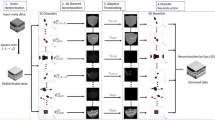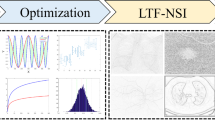Abstract
Speckle noise reduces the image contrast significantly making the highly scattering structures boundaries difficult to distinguish. This has limited the usage of optical coherence tomography (OCT) images in clinical routine and hindered its potential by depriving clinicians from assessing useful information that are needed in disease monitoring, treatment, progression, and decision making. To overcome this limitation, we propose a fast and robust OCT image enhancement framework using non-linear statistical parametric technique. In the proposed framework, we utilize prior statistical information to model the image to follow Gaussian distribution. After which, a newly designed dual-parametric sigmoid function (DPSF) is utilized to control the dynamic range and contrast level of the image. To balance the intensity range and contrast level, both linear and non-linear normalization operations are performed, then followed by a mapping operation to obtain the enhanced image. Experimentation results on the three OCT vendors show that the proposed method obtained high values in EME, PSNR, SSIM, ρ, and low value in MSE of 36.72, 38.87, 0.87, 0.98, and 25.12 for Cirrus; 40.77, 41.84, 0.89, 0.98, and 22.15 for Spectralis; and 30.81, 32.10, 0.81, 0.96, and 28.55 for Topcon OCT devices, respectively. The proposed DPSF framework performs better than the state-of-the-art methods and improves the interpretability and perception of the OCT images, which can provide clinicians and computer vision program with good quantitative and qualitative information.
Graphical abstract








Similar content being viewed by others
References
Ly E et al (2019) An evidence-based approach to the routine use of optical coherence tomography. Clin Exp Optom 102:242–259
Nakano T et al (2017) Applicability of automatic spectral domain optical coherence tomography for glaucoma mass screening. Clin Ophthalmol 11:97–103
Joe P et al (2018) A pilot study assessing retinal pathology in psychosis using optical coherence tomography: choroidal and macular thickness. Psychiatry Res 263:158–161
Alonso R, Gonzalez-Moron D, Garcea O (2018) Optical coherence tomography as a biomarker of neurodegeneration in multiple sclerosis: a review. Mult Scler Relat Disord 22:77–82
Lee SY, Hong MK (2013) Stent evaluation with optical coherence tomography. Yonsei Med J 54(5):1075–1083
Monroy GL et al (2017) Clinical translation of handheld optical coherence tomography: practical considerations and recent advancements. Journal Biomedical Optics 22:1–30
Regatieri CV, Branchini L, Duker JS (2011) The role of spectral-domain OCT in the diagnosis and management of neovascular age-related macular degeneration. Ophthalmic Surg Lasers Imaging 42:56–66
Huang D et al (2015) OCT angiography of time course of choroidal neovascularization in response to anti-angiogenic treatment. Retina 35(11):2260–2264
Merkle CW, Srinivasan VJ (2016) Laminar microvascular transit time distribution in the mouse somatosensory cortex revealed by dynamic contrast optical coherence tomography. Neuroimage 125:350–362
Salas M et al (2017) Visualization of micro-capillaries using optical coherence tomography angiography with and without adaptive optics. Biomed Opt Express 8(1):207–222
Schneider EW, Fowler SC. Optical coherence tomography angiography in the management of age‐related macular degeneration. Curr Opin Ophthalmol 29:2179, pp. 2177
Folgar FA et al (2012) Spatial correlation between hyperpigmentary changes on color fundus photography and hyperreflective foci on SD-OCT in intermediate AMD. Invest Ophthalmol Vis Sci 53:4626–4633
Chitchian S, Mayer M, Boretsky AR, VanKuijk FJ, Motamedi M (2012) Retinal optical coherence tomography image enhancement via shrinkage denoising using double-density dual-tree complex wavelet transform. Journal of Biomedical Optics 17:116009–4
Anantrasirichai N et al (2014) Adaptive-weighted bilateral filtering and other pre-processing techniques for optical coherence tomography. Comput Med Imaging Graph 38:526–539
Liu G, Wang Z, Mu G, Li P (2018) Efficient OCT image enhancement based on collaborative shock filtering. J Healthc Eng 7329548:1–7
Li M et al (2018) Structure-revealing low-light image enhancement via robust retinex model. IEEE Trans Image Proc 27:2828–2841
Ying Z, Li G, Gao W (2015) A bio-inspired multi-exposure fusion framework for low-light image enhancement,” ArXiv:1711.00591
Chitchian S, Fiddy M, Fried N (2009) Denoising during optical coherence tomography of the prostate nerves via wavelet shrinkage using dual-tree complex wavelet transform. J Biomed Optics 14(1):014031
Febin IP, Jidesh P (2021) Despeckling and enhancement of ultrasound images using non-local variational framework. Vis Computer. https://doi.org/10.1007/s00371-021-02076-8
Mhala NC, Pais AR (2021) A secure visual secret sharing (VSS) scheme with CNN-based image enhancement for underwater images. Vis Computer 37:2097–2111
Joshi P, Prakash S (2021) Image enhancement with naturalness preservation. Vis Computer 36:71–83
Ling Y et al (2012) Adaptive tone-preserved image detail enhancement. Vis Computer 28:733–742
Li Y et al (2021) Self-supervised monocular depth estimation based on image texture detail enhancement. Vis Computer. https://doi.org/10.1007/s00371-021-02206-2
Wang C, He C, Xu M (2021) Fast exposure fusion of detail enhancement for brightest and darkest regions. Vis Computer 37:1233–1243
Lou S et al (2021) Fast OCT image enhancement method based on the sigmoid-energy conservation equation. Biomed Opt Express 12:1792–1803
Okuwobi IP et al (2020) Hyperreflective foci enhancement in a combined spatial-transform domain for SD-OCT images. Translational Vision Science & Technology 9:19–19
Xing G et al (2022) Multi-scale pathological fluid segmentation in OCT with a novel curvature loss in convolutional neural network. IEEE Trans Med Imaging. https://doi.org/10.1109/TMI.2022.3142048
Xie H et al (2021) Globally optimal OCT surface segmentation using a constrained IPM optimization. Opt Express 30:2453–2471
Okuwobi IP et al (2020) Automated quantification of hyperreflective foci in SD-OCT with diabetic retinopathy. IEEE J Biomed Health Inform 24:1125–1136
Wang J et al (2021) Weakly supervised anomaly segmentation in retinal OCT images using an adversarial learning approach. Biomed Opt Express 12:4713–4729
Okuwobi IP et al (2019) Automated segmentation of hyperreflective foci in spectral domain optical coherence tomography with diabetic retinopathy,". Journal of medical imaging 5:014002
McHugh ML (2012) Interrater reliability: the kappa statistic. Biochem Med (Zagreb) 22:276–282
Funding
This work was supported by the Youth Science and Technology Fund of Guangxi Natural Science Foundation (2021GXNSFBA220075), a grant from the Guangxi Postdoctoral Special Support Fund (C21RSC90ZN02), Scientific Research Fund (YXRSZN03 and UF20035Y).
Author information
Authors and Affiliations
Corresponding author
Ethics declarations
Conflict of Interest
The authors declare no competing interests.
Additional information
Publisher's Note
Springer Nature remains neutral with regard to jurisdictional claims in published maps and institutional affiliations.
Rights and permissions
About this article
Cite this article
Okuwobi, I.P., Ding, Z., Wan, J. et al. DPSF: a Novel Dual-Parametric Sigmoid Function for Optical Coherence Tomography Image Enhancement. Med Biol Eng Comput 60, 1111–1121 (2022). https://doi.org/10.1007/s11517-022-02538-8
Received:
Accepted:
Published:
Issue Date:
DOI: https://doi.org/10.1007/s11517-022-02538-8




